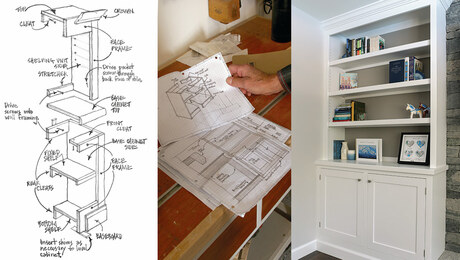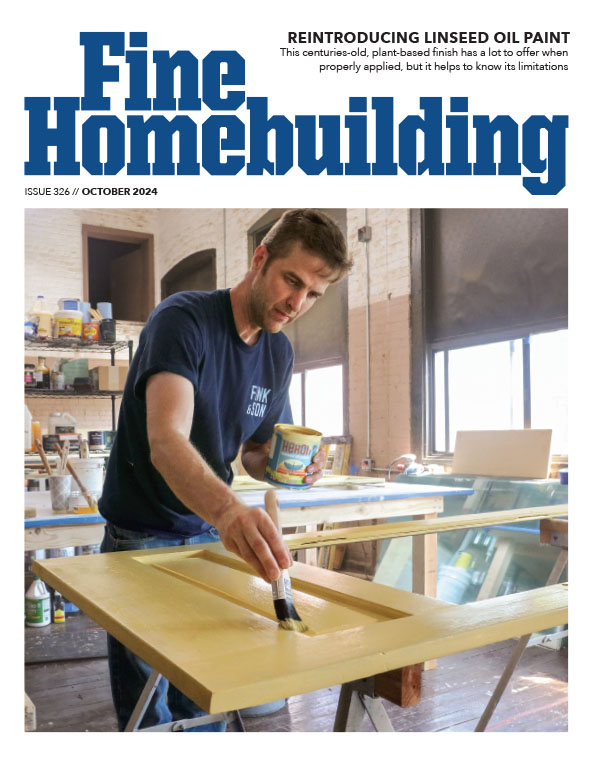What’s the scoop on installing fiberglas insulation batts, staple inside, or to the face. pro’s and cons, behind a “install to the studs” shower unit (Sterling) on an exterior wall. What about a vapor barrier ( poly sheet) over the insulation?
Edited 9/24/2005 6:30 pm ET by popeye87















Replies
The vapor barrier usually faces the warm side. I'd staple to the inside and then add a layer of building paper over the studs because the paper or plastic on the FG batts isn't continuous.
I meant stapling to the edges, or the faces, of the studs, on the inside wall.
should the kraft paper be sliced (vapor barrier over vapor barrier?) or would it be
better to use insulation without the kraft and add a single vapor barrier of poly or
building paper as a vapor barrier. There also is 1" Fomular on the outside of the
3/4" T&G sheathing, and then the siding, is this going to trap moisture in the wall
area of the bath?
I have only seen an added vapor barrier (poly) over blown-in insulation, never over faced FG batts. If you can get blown-in, do it.
With faced FG I like to staple to the inside edge of the stud so that my rocker can glue the rock to the studs more easily. However, the inspectors like to see it stapled to the faces, so I try to leave 1/2" of wood showing down the center of the stud for the adhesive.
The same inspectors usually believe in paint as a VB. I'm not sure about that, I've heard at least one building science guy so it doesn't work.
The vapor barrier is supposed to keep moisture out of the wall cavities where cooler air can cause it to condense. In a shower/bath wall, you need a good, continuous vapor barrier because the air in a bathroom will be very humid several times a day. Any large continuous film, paper, poly, whatever is going to be more effective than just the paper or plastic on the FG batts, IMHO.
Faced batt insulation is meant to be stapled to the face of the studs. Stapling to the inside of the studs collapses the insulation a bit and creates a colder spot.
If you are going to add a separate vapor barrier you should install unfaced batts. If you put a vapor barrier over faced batts you could trap moisture between them. In theory no moisture should be able to get between, but in real life there will be tiny tears or poor seals in the vapor barrier that will let moisture past.
In the bathroom especially be real fussy about sealing the vapor barrier carefully.
Thanks to one and all for your input!
Wayne
I'm asking because I don't know. If you put a vapor barrier on the entire house, say you use visqueen(sp?) wouldn't you trap all that moisture inside your house?
And if you did trap all that moisture in the house would an air exchanger take care of that problem?
I don't know sh!t about vapor barriers and am trying to understand some of the science involved.
Thanks
Doug
Here's a quick summary of how vapor barriers work. I'm going to describe for a cold climate such as the northern US. I haven't studied enough about warm climates to discuss those.
The amount of moisture air can hold depends on its temperature. Warm air can hold considerable more moisture than cold. That's why when warm air containing moisture contacts a cold surface the moisture condenses out as liquid water -- the colder air just can't hold it.
The normal activities of daily living produce moisture. These come from cooking, bathing, laundry, etc. These activities raise the moisture level of the air in the house. If that air were cooled sufficiently the moisture would condense out. In the winter the outside temperature is quite cold. The air in a typical house would condense out moisture if it were cooled as cold as the outside of the house was. That's why you often see moisture on the insides of poorly insulated windows (and even well insulated windows if the outside is cold enough).
Air moves through the walls of the house. It passes through tiny cracks as around electrical outlets, joints in trim, holes drilled in studs for wiring and plumbing, and so forth. Moisture also passes through solid materials such as drywall. When moisture or moist indoor air passes through a wall it becomes colder as it passes from inside to outside. Somewhere between it gets to a temperature at which it will condense. When it does it wets insulation and wood and causes rot.
A vapor barrier is a material that blocks air and moisture movement. In northern climates the vapor barrier is placed on the inside of insulation. That keeps moist air or moisture from getting into the insulation where, if it traveled far enough through it, it would cool off enough to condense out and wet the material.
No vapor barrier is perfect, so a small bit of moisture does make its way into a wall or ceiling. On the exterior, you don't want to retard this moisture from getting out. If it were retarded it would build up in the wall and cause condensation. By letting it out freely you can keep the level low enough so that it doesn't condense. The materials that go on the outside of a house, i.e. housewrap, are designed to let moisture vapor out. A vapor-impermeable substance, like plastic sheet, should never be used on the outside of a home (in a cold climate).
So (in a cold climate) the vapor barrier goes on the inside (warm) side of insulation, and vapor is left to escape on the outside by using materials that let moisture out.
Great post. In your opinion, does moisture that gets into walls continue to migrate to the outside thru materials such as Tyvek or felt?
That is what Tyvek and builder's paper is supposed to do: Allow vaporized moisture to escape from the building envelope.
Here in centeral NCwe have a mixed heating/cooling climate but, I guess siince it is mild, we see little insulation other than fiberglass. 5 to 7 years ago most everyone was using unfaced fiberglass batts in the walls with poly vapor barrier stapled on the inside. Now a days, not many builder's do that because of all the concerns about mold being caused by moisture trapped in the walls. Really though the mold problems are caused by poor detailing of the exterior cladding and the secondary weather barrier.
My preference is face stapled batts of paper faced insulation. The face stapling make for less air between the sheetrock and the insulation which can result in air currents and cold air pockets within the building envelope.
Well done Matt!
What are your and the forum's thoughts of insulating and old 1920's balloon frame with blown in cellulose in the stud bays and 1" fomular on top of the original 13/16" T&G sheathing, before reinstalling vinyl siding.
I'd like to hear pros and cons about this because I seem to hear such varied opinions on this method.
Exactly where would the foam go and what type of foam is it?
The cellulose insulation is much better at blocking air movement.
The foam is OC pink foamular insulation board, 1"/ R5. After stripping off the old lap siding it will go over the 13/16" T&G pine sheathing, building me up to the right plane that the window trim/ siding receiver already installed is at. At this point, I intend to blow in cellulose in the wall cavities as I get the old aluminum siding and lap siding removed, install the 1" foam, and then the new vinyl siding.